Wild Edible Of The Week - Week 21 - "Horse Mushroom"
Botanical name : Agaricus arvensis
Common names : Horse mushroom,
Von.grzanka, CC BY-SA 3.0 <https://creativecommons.org/licenses/by-sa/3.0>, via Wikimedia Commons
Physical appearance : Looks like a very large "field" mushroom (see last week's post), but larger, sometimes up to the size of a plate (up to 20cm across). Can grow up to 15cm in height. The scent it produces has been likened to almonds or aniseed. Its gills are initially pinkish in appearance then turn to a dark grey as the mushrooms matures. When the mushroom is very young, the cap is more oval than rounded. As it matures, the cap flattens out. The caps on young specimens have a yellowish tinge and get whiter as they mature.
(Immature specimen with closed cap and "cogwheel" pattern).
Edible parts : As with most edible mushrooms the cap and stalk can be eaten.
Best places to find : Pastures, lawns and hedgerows. Often found in close proximity to stinging nettles as it also likes nutrient rich soil.
Time of year : This fungi tends to ripen between July and August.

By © Salix / Wikimedia Commons, CC BY-SA 3.0, https://commons.wikimedia.org/w/index.php?curid=4826164
Serving suggestions : There are many recipes for field mushrooms, especially as these are very common and eaten widely. For a puritan recipe, remove all debris with brush or damp cloth. Melt a generous knob of butter in a frying pan on a medium heat. Once melted and bubbling lightly, add the mushrooms whole and fry for 3-4 minutes only. As wild mushrooms generally contain more water than cultivated varieties, cooking them for longer may cause them to stew in their own juices making them rubbery. Keep cooking times short. Season with salt and pepper and serve with a slice of buttered bread. Delicious! This recipe works well for many wild mushrooms.
Other : Slice the mushrooms thinly and fry in a little oil. Mix in some fresh pesto sauce and serve on pasta.
Poisonous mushrooms!!!! - Please be sure you know what you are picking. Many plants look similar to one another and many can be poisonous! Please seek professional instruction if you are unsure! Don't risk your life!!!
Discard any mushrooms that look similar but have pure white gills or leave pink or yellow stains when handled. Two mushrooms commonly mistaken for the horse mushroom are the "blusher" and the yellow staining mushroom (Amontia rubescens and Agaricus xanthodermus respectively). Neither is generally fatally poisonous but both can cause serious stomach upsets leading to violent vomiting.


